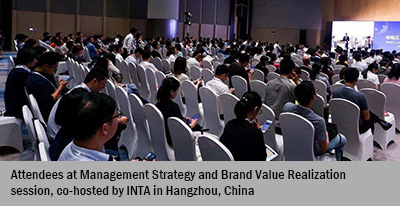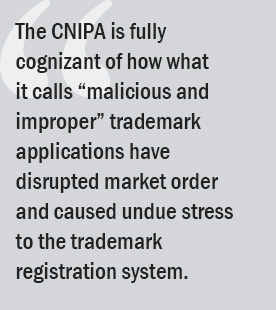INTA Deepens Key Partnership in Hangzhou, China
Published: September 15, 2019
INTA strengthened its collaboration with the Intellectual Property Publishing House (IPPH) of China during a joint Session of Trademark Management Strategy and Brand Value Realization at the China Intellectual Property Annual Conference (CIPAC) in Hangzhou, China, on September 2.

This year, the CIPAC included sessions on trademarks and geographical indicators in addition to existing patents and industrial designs to reflect the fundamental role that intellectual property (IP) plays in every aspect of a rapidly developing China. Subjects also spanned such emerging topics as ecommerce, artificial intelligence, 5G technology, and blockchain.
INTA co-hosted a session with IPPH on Trademark Management Strategy and Brand Value Realization, which delved into the topic of how to manage brand portfolios in an increasingly competitive international market as multinational corporations develop customized business strategies to fit their target markets. Speakers included INTA Chief Representative Officer Asia-Pacific Seth Hays, Robin Lynne Smith (Lego, China and Asia-Pacific) and Becky Wang (S.C. Johnson, Asia). Other speakers included representatives from AMORE Pacific, the EU Chamber of Commerce, Luckin Coffee, Sony, and Xiaomi Inc.
 Ms. Smith detailed three main challenges Lego has faced in China, including trademark hijacking, unauthorized use, and counterfeits. He noted that a multi-tiered IP strategy should be designed to adapt to the variability of markets from region to region in China, and that civil, administrative, and criminal implications must be taken into account in each scenario.
Ms. Smith detailed three main challenges Lego has faced in China, including trademark hijacking, unauthorized use, and counterfeits. He noted that a multi-tiered IP strategy should be designed to adapt to the variability of markets from region to region in China, and that civil, administrative, and criminal implications must be taken into account in each scenario.
In a presentation focused on trademark management and brand protection strategy in a global market, Ms. Wang advised that a comprehensive trademark search and clearance should be conducted regarding every element of a proposed trademark design, including words, graphics, color, and meaning. This process should also take into consideration the management of licensing with suppliers involving non-standard use and sub-licensing risks. She went on to explain that the growth of a brand relies on the joint efforts of business teams, supply chain representatives, public relations and communication teams, as well as attorneys and third-party vendors. In addition, Ms. Wang emphasized the importance of cooperation with government enforcement agencies and verification by legitimate brand owners.
Mr. Hays pointed to INTA’s recent study, Gen Z Insights: Brands and Counterfeit Products, which explores young consumers’ relationships with brands and their attitudes and perceptions of counterfeit products across 10 markets, including China. He highlighted one of the study’s key findings, which showed that as the influence and purchasing power of young consumers increase, so do their expectations of genuine brands. In that sense, he explained, counterfeiting is undermining consumer expectation and trust because it is diminishing the ability to protect consumers.
INTA’s China Representative Office, based in Shanghai, represents the Association’s 246 members in China. Working in collaboration with staff at INTA’s headquarters in New York City, the China Representative Office leads the Association’s policy, membership, marketing, and communications initiatives in this jurisdiction. To learn more about INTA’s activities in China, please contact INTA’ China Representative Monica Su at @[email protected].
Although every effort has been made to verify the accuracy of items in the INTA Bulletin, readers are urged to check independently on matters of specific concern or interest.
© 2019 International Trademark Association
This website uses cookies so that we can provide you with the best user experience possible. Cookie information is stored in your browser and performs functions such as recognising you when you return to our website and helping our team to understand which sections of the website you find most interesting and useful.
To find out more please see our Cookies Policy and Privacy Policy.
These cookies are used to identify a user’s browser as the visitor goes from page to page on the Site. These are session cookies, which means that the cookie is deleted when you leave the Site. It is an integral piece of the Site software and used to let the server know which users are on the Site at any given time and make certain parts of the Site easier to use.
|
|
If you disable this cookie, we will not be able to save your preferences. This means that every time you visit this website you will need to enable or disable cookies again.
These cookies are used to collect information about how visitors use our Site. The cookies collect information in anonymous form, including the numbers of visitors to the Site, where visitors have come to the Site from, the pages they visited and how they have interacted with tools on the Site like search and embedded media players. We use the information to compile statistical reports of our users’ browsing patterns so that we can improve the Site.
|
|
Please enable Functionality Cookies first so that we can save your preferences!
These cookies are used to deliver advertising relevant to the interests of visitors to our Site. They are persistent, which means they will remain on your device after you leave the Site.
- Facebook (Ad Pixel)
- Google (Ad Pixel)
- LinkedIn (Ad Pixel)
- Quattro Anonymous
Please enable Functionality Cookies first so that we can save your preferences!
